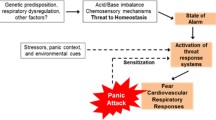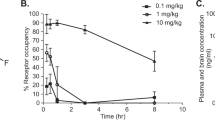Abstract
Rationale
Experimental panic induction with cholecystokinin-tetrapeptide (CCK-4) has been established as a model to study the pathophysiology of panic disorder and might serve as a tool to asses the antipanic potential of novel anxiolytic compounds. However, assessment of CCK-4-induced panic does not follow consistent rules.
Objectives
To provide a basis for the use of the CCK-4 model in proof-of-concept studies, we investigated CCK-4-induced panic according to different criteria in 85 healthy volunteers who underwent a CCK-4 bolus injection.
Methods
We assessed panicker/non-panicker ratios according to different panic criteria and explored whether differences in cardiovascular and neuroendocrine responses to CCK-4 paralleled subjective panic responses. Subjective panic responses were measured with the Acute Panic Inventory (API) and the Panic Symptom Scale (PSS). Heart rate, blood pressure, adrenocorticotropic hormone (ACTH) and cortisol were assessed concomitantly.
Results
The API-derived panic rate was 10.6% higher than that derived from the PSS. CCK-4 induced an increase in heart rate, systolic blood pressure and ACTH/cortisol plasma levels, which did not differ between panickers and non-panickers.
Conclusions
The panic criterion applied appears to be of major importance for the panic rate achieved, whereas CCK-4-induced cardiovascular and hormonal alterations are not valuable as an objective “read out”. The CCK-4 challenge might serve as a useful model to study putative anxiolytic effects of novel compounds during the early phase of drug development if the challenge procedure is carried out according to strictly comparable conditions.


Similar content being viewed by others
References
Abelson JL, Liberzon I (1999) Dose response of adrenocorticotropin and cortisol to the CCK-B agonist pentagastrin. Neuropsychopharmacology 21:485–494
Abelson JL, Liberzon I, Young EA, Khan S (2005) Cognitive modulation of the endocrine stress response to a pharmacological challenge in normal and panic disorder subjects. Arch Gen Psychiatry 62:668–675
Ackenheil M, Stotz G, Dietz-Bauer R, Vossen A (1999) Mini International Neuropsychiatric Interview, German version 5.0.0
Akiyoshi J, Isogawa K, Tsutsumi T, Kasturagi S, Kohno K, Furuta M, Yamamoto Y, Yamada K, Fujii I (1997) Cholecystokinin tetrapeptide-induced calcium mobilization in T cells of patients with panic disorder, major depression, or schizophrenia. Biol Psychiatry 42:151–154
Aluoja A, Shlik J, Vasar V, Kingisepp PH, Jagomagi K, Vasar E, Bradwejn J (1997) Emotional and cognitive factors connected with response to cholecystokinin tetrapeptide in healthy volunteers. Psychiatry Res 66:59–67
Beinfeld MC, Meyer DK, Eskay RL, Jensen RT, Brownstein MJ (1981) The distribution of cholecystokinin immunoreactivity in the central nervous system of the rat as determined by radioimmunoassay. Brain Res 212:51–57
Bradwejn J, Koszycki D (1994a) Imipramine antagonism of the panicogenic effects of cholecystokinin tetrapeptide in panic disorder patients. Am J Psychiatry 151:261–263
Bradwejn J, Koszycki D (1994b) The cholecystokinin hypothesis of anxiety and panic disorder. Ann NY Acad Sci 713:273–282
Bradwejn J, Koszycki D (2001) Cholecystokinin and panic disorder: past and future clinical research strategies. Scand J Clin Lab Invest 61(Suppl):19–27
Bradwejn J, Koszycki D, Meterissian G (1990) Cholecystokinin-tetrapeptide induces panic attacks in patients with panic disorder. Can J Psychiatry 35:83–85
Bradwejn J, Koszycki D, Shriqui C (1991) Enhanced sensitivity to cholecystokinin tetrapeptide in panic disorder. Clinical and behavioral findings. Arch Gen Psychiatry 48:603–610
Bradwejn J, Koszycki D, Payeur R, Bourin M, Borthwick H (1992) Replication of action of cholecystokinin tetrapeptide in panic disorder: clinical and behavioral findings. Am J Psychiatry 149:962–964
Bradwejn J, Koszycki D, Couetoux du TA, van Megen H, den Boer J, Westenberg H (1994) The panicogenic effects of cholecystokinin-tetrapeptide are antagonized by L-365,260, a central cholecystokinin receptor antagonist, in patients with panic disorder. Arch Gen Psychiatry 51:486–493
Bradwejn J, Koszycki D, Paradis M, Reece P, Hinton J, Sedman A (1995) Effect of CI-988 on cholecystokinin tetrapeptide-induced panic symptoms in healthy volunteers. Biol Psychiatry 38:742–746
Bradwejn J, LeGrand JM, Koszycki D, Bates JH, Bourin M (1998) Effects of cholecystokinin tetrapeptide on respiratory function in healthy volunteers. Am J Psychiatry 155:280–282
Brambilla F, Bellodi L, Perna G, Garberi A, Panerai A, Sacerdote P (1993) Lymphocyte cholecystokinin concentrations in panic disorder. Am J Psychiatry 150:1111–1113
de Montigny C (1989) Cholecystokinin tetrapeptide induces panic-like attacks in healthy volunteers. Preliminary findings. Arch Gen Psychiatry 46:511–517
Dillon DJ, Gorman JM, Liebowitz MR, Fyer AJ, Klein DF (1987) Measurement of lactate-induced panic and anxiety. Psychiatry Res 20:97–105
Engel RR (2000) Minnesota Multiphasic Personality Inventory-2. In: Hathaway SR, Mc Kinley JC, Engel RPotTGv (eds) University of Minnesota, Minneapolis, MN
Flint AJ, Koszycki D, Vaccarino FJ, Cadieux A, Boulenger JP, Bradwejn J (1998) Effect of aging on cholecystokinin-induced panic. Am J Psychiatry 155:283–285
Kellner M, Yassouridis A, Jahn H, Wiedemann K (1997) Influence of clonidine on psychopathological, endocrine and respiratory effects of cholecystokinin tetrapeptide in patients with panic disorder. Psychopharmacology (Berl.) 133:55–61
Kellner M, Yassouridis A, Hua Y, Wendrich M, Naber D, Wiedemann K (2002) Trait dissociation affects the behavioral response to cholecystokinin tetrapeptide in healthy man. Psychiatry Res 111:93–96
Kellner M, Muhtz C, Stark K, Yassouridis A, Arlt J, Wiedemann K (2005) Effects of a metabotropic glutamate(2/3) receptor agonist (LY544344/LY354740) on panic anxiety induced by cholecystokinin tetrapeptide in healthy humans: preliminary results. Psychopharmacology (Berl) 179:310–315
Kennedy JL, Bradwejn J, Koszycki D, King N, Crowe R, Vincent J, Fourie O (1999) Investigation of cholecystokinin system genes in panic disorder. Mol Psychiatry 4:284–285
Khan S, Liberzon I, Abelson JL (2004) Effects of propranolol on symptom and endocrine responses to pentagastrin. Psychoneuroendocrinology 29:1163–1171
Koszycki D, Cox BJ, Bradwejn J (1993) Anxiety sensitivity and response to cholecystokinin tetrapeptide in healthy volunteers. Am J Psychiatry 150:1881–1883
Koszycki D, Zacharko RM, Bradwejn J (1996a) Influence of personality on behavioral response to cholecystokinin-tetrapeptide in patients with panic disorder. Psychiatry Res 62:131–138
Koszycki D, Zacharko RM, Le Melledo JM, Young SN, Bradwejn J (1996b) Effect of acute tryptophan depletion on behavioral, cardiovascular, and hormonal sensitivity to cholecystokinin-tetrapeptide challenge in healthy volunteers. Biol Psychiatry 40:648–655
Koszycki D, Zacharko RM, Le Melledo JM, Bradwejn J (1998) Behavioral, cardiovascular, and neuroendocrine profiles following CCK-4 challenge in healthy volunteers: a comparison of panickers and nonpanickers. Depress Anxiety. 8:1–7
Le Melledo JM, Bradwejn J, Koszycki D, Bichet D (1995) Premenstrual dysphoric disorder and response to cholecystokinin-tetrapeptide. Arch Gen Psychiatry. 52:605–606
Le Melledo JM, Merani S, Koszycki D, Bellavance F, Palmour R, Gutkowska J, Steinberg S, Bichet DG, Bradwejn J (1999) Sensitivity to CCK-4 in women with and without premenstrual dysphoric disorder (PMDD) during their follicular and luteal phases. Neuropsychopharmacology 20:81–91
Le Melledo JM, Arthur H, Dalton J, Woo C, Lipton N, Bellavance F, Koszycki D, Boulenger JP, Bradwejn J (2001) The influence of Type A behavior pattern on the response to the panicogenic agent CCK-4. J Psychosom Res 51:513–520
Lines C, Challenor J, Traub M (1995) Cholecystokinin and anxiety in normal volunteers: an investigation of the anxiogenic properties of pentagastrin and reversal by the cholecystokinin receptor subtype B antagonist L-365,260. Br J Clin Pharmacol 39:235–242
Lydiard RB, Ballenger JC, Laraia MT, Fossey MD, Beinfeld MC (1992) CSF cholecystokinin concentrations in patients with panic disorder and in normal comparison subjects. Am J Psychiatry 149:691–693
Moran TH, Robinson PH, Goldrich MS, McHugh PR (1986) Two brain cholecystokinin receptors: implications for behavioral actions. Brain Res 362:175–179
Rehfeld JF, Neilson FC (1995) Molecular form and regional distribution of cholecystokinin in the central and peripheral nervous system. In: Bradwejn J, Vasar E (eds) Cholecystokinin and anxiety: from neuron to behaviour. Springer, Austin, pp 33–56
Shlik J, Aluoja A, Vasar V, Vasar E, Podar T, Bradwejn J (1997) Effects of citalopram treatment on behavioural, cardiovascular and neuroendocrine response to cholecystokinin tetrapeptide challenge in patients with panic disorder. J Psychiatry Neurosci 22:332–340
Strohle A, Holsboer F, Rupprecht R (2000) Increased ACTH concentrations associated with cholecystokinin tetrapeptide-induced panic attacks in patients with panic disorder. Neuropsychopharmacology 22:251–256
van Megen HJ, Westenberg HG, den Boer JA, Kahn RS (1996) Cholecystokinin in anxiety. Eur Neuropsychopharmacol 6:263–280
van Megen HJ, Westenberg HG, den Boer JA, Slaap B, Scheepmakers A (1997) Effect of the selective serotonin reuptake inhibitor fluvoxamine on CCK-4 induced panic attacks. Psychopharmacology (Berl) 129:357–364
Wiedemann K, Jahn H, Yassouridis A, Kellner M (2001) Anxiolyticlike effects of atrial natriuretic peptide on cholecystokinin tetrapeptide-induced panic attacks: preliminary findings. Arch Gen Psychiatry 58:371–377
Zwanzger P, Baghai TC, Schuele C, Strohle A, Padberg F, Kathmann N, Schwarz M, Moller HJ, Rupprecht R (2001) Vigabatrin decreases cholecystokinin-tetrapeptide (CCK-4) induced panic in healthy volunteers. Neuropsychopharmacology 25:699–703
Zwanzger P, Eser D, Aicher S, Schule C, Baghai TC, Padberg F, Ella R, Moller HJ, Rupprecht R (2003a) Effects of alprazolam on cholecystokinin-tetrapeptide-induced panic and hypothalamic-pituitary-adrenal-axis activity: a placebo-controlled study. Neuropsychopharmacology 28:979–984
Zwanzger P, Eser D, Padberg F, Baghai TC, Schule C, Rotzer F, Ella R, Moller HJ, Rupprecht R (2003b) Effects of tiagabine on cholecystokinin-tetrapeptide (CCK-4)-induced anxiety in healthy volunteers. Depress Anxiety 18:140–143
Acknowledgement
We thank Dr. Daniel Umbricht and Janice Branson, Exploratory Clinical Development, Novartis Pharma AG, Basel, Switzerland and Jimmy Fernandes, NICCI-B&SR, Novartis Healthcare, Novartis Pharma AG, India for critically reading the manuscript and valuable comments and advice. Furthermore, we thank Silvia Esler and Maria Ertl for expert technical assistance. This research was part of a proof-of-concept study sponsored by Novartis Pharma AG, Basel, Switzerland.
Author information
Authors and Affiliations
Corresponding author
Rights and permissions
About this article
Cite this article
Eser, D., Schüle, C., Baghai, T. et al. Evaluation of the CCK-4 model as a challenge paradigm in a population of healthy volunteers within a proof-of-concept study. Psychopharmacology 192, 479–487 (2007). https://doi.org/10.1007/s00213-007-0738-7
Received:
Accepted:
Published:
Issue Date:
DOI: https://doi.org/10.1007/s00213-007-0738-7




